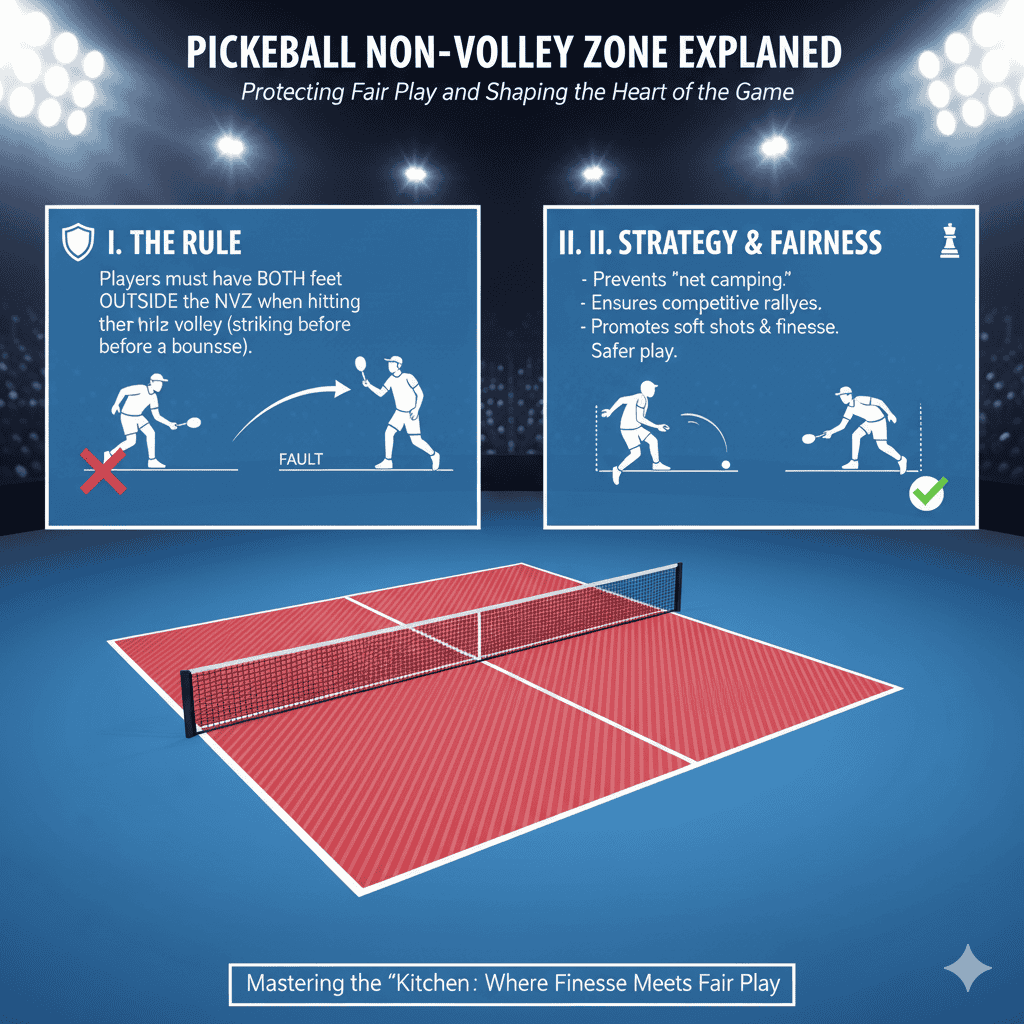Pickleball Non-Volley Zone Rules Explained
Protecting Fair Play and Shaping the Heart of the Game
On the pickleball court, the non-volley zone—often called the “kitchen”—stands as one of the sport’s most defining and fascinating rules.
It serves not only as a safeguard for fair competition but also as the source of countless brilliant rallies, strategic mind games, and moments of extraordinary finesse.
The non-volley zone sits on each side of the net and extends back a fixed distance.
Although this area may seem small, its role is crucial.
At its core, the rule states that players must have both feet outside the non-volley zone when making a volley, meaning they cannot strike the ball out of the air while standing within this area.
This simple guideline carries deep significance and touches every part of the sport.
Fairness and Balance: The Rule That Levels the Playing Field
Without the non-volley zone, players—especially taller or stronger ones—could dominate with close-range, overpowering smashes right at the net.
This would make it nearly impossible for opponents to defend effectively, shifting the sport away from strategy and toward physical advantage.
The non-volley zone acts as a strategic equalizer.
It prevents players from standing directly over the net and demolishing every return, ensuring that rallies remain competitive and engaging.
By creating a buffer area, players of various sizes, strengths, and styles can compete on a more even playing field.
Imagine a match where one player constantly camps at the net and fires unreturnable volleys—without the NVZ, gameplay would lose its strategic layers.
The rule preserves balance, fairness, and the essential spirit of pickleball.
Shaping Strategy: A Rule That Creates Infinite Tactical Possibilities
The non-volley zone adds a rich strategic dimension to pickleball.
Players must constantly evaluate where the ball lands—inside or outside the NVZ—to determine how to attack or defend.
• When the ball is outside the NVZ, players can advance to the net for aggressive volleys, punch shots, or decisive putaways.
• When the ball enters the NVZ, players must change tactics immediately—opting for soft shots, precise dinks, and carefully placed returns that maintain position without violating the rule.
In doubles play, this becomes even more intricate.
Partners must coordinate their roles: one creating opportunities outside the NVZ while the other monitors the ball’s movement into the kitchen, ready to shift from offense to defense in an instant.
These dynamic transitions keep the game unpredictable and thrilling.
A Test of Technique: Precision Over Power
Because power cannot be freely used near the net, players must rely on accuracy, touch, and control when working around the NVZ.
This rule pushes players to develop a broader range of skills, such as:
• Dinks that delicately drop the ball into tight spaces
• Slices that add spin and alter trajectory
• Push shots that glide the ball across the net with minimal height
• Lobs that reset the rally and force opponents backward
For example, when a ball lands deep near the NVZ line, a well-executed soft cut shot can send the ball spinning toward the corner, disrupting the opponent's rhythm.
Or when an opponent pressures the net, a precise push or crosscourt dink can shift control of the rally.
Mastery of these skills elevates players' performance and drives the sport’s ongoing evolution.
Safety First: Protecting Players in Close-Range Exchanges
The non-volley zone rule also serves a practical purpose: preventing injuries.
Allowing full-power swings at close range could lead to dangerous collisions or high-speed impacts.
By restricting volleys in tight spaces, players are encouraged to maintain safer court distances, reducing the risk of accidents during intense matches.
Conclusion: The Non-Volley Zone—A Pillar of Pickleball’s Identity
The non-volley zone is one of the most influential and iconic components of pickleball’s rule system.
It preserves fairness, enriches tactical depth, encourages technical skill, enhances player safety, and creates some of the most captivating moments in the sport.
For professionals, enthusiasts, and newcomers alike, understanding and respecting the NVZ rules is key to appreciating the full beauty and complexity of pickleball.

BHI Pickleball-Custom pickleball paddle






